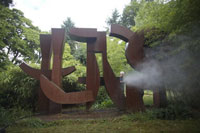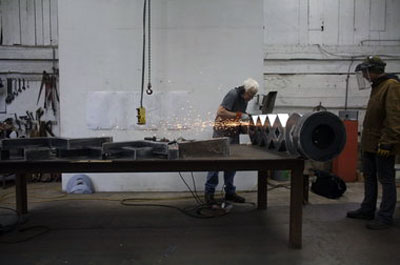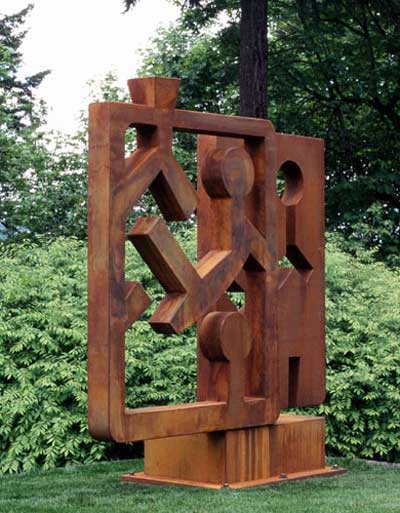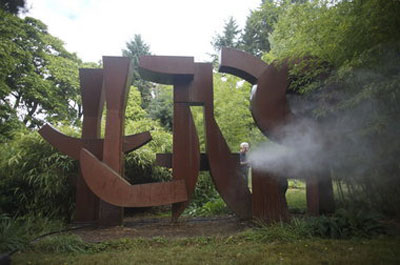
 Sculpture News at SculptSite.com
Sculpture News at SculptSite.com
Lee Kelly Sculpture |
 |
| The Oregonian by D.K. Row Profile: Northwest sculptor Lee KellyYou might not know Lee Kelly's name, but you've surely seen his artwork. His serene fountain at Washington Park, for example -- a memorial made to honor the man who christened Portland "The City of Roses," Frank L. Beach. Or the massive Cor-ten steel structures on the corner of Southwest Lincoln Street and First Avenue. Or the playful weaving of various hook, post and circle shapes in front of Legacy Salmon Creek Hospital in Vancouver. If there's a romantic ideal of an Oregon artist, it might be Kelly -- sculptor, climber, gentleman. He's artist as rugged survivor, a man who's remained true to his path whatever the artistic changes of the day, and no matter what personal upheaval he's encountered. Kelly was the finest public artist working in the Northwest in the 1960s and '70s, producing works of monumental scale and beauty -- from one at San Francisco's Candlestick Park to another at Portland's North Waterfront Park. More than 30 works by him still stand in public spaces in Oregon, including Clackamas Community College in Oregon City, the University of Oregon in Eugene and The Oregon Garden in Silverton. He's also among the best studio artists of his generation, grappling early in his career with Modernist issues of scale and form and later infusing these enduring concepts with influences drawn from his world travels. Equal to these artistic accomplishments has been the way this quiet, charismatic 78-year-old has lived through both professional success and personal adversity: with stoic grace. A public bond Surrounded by well-wishers during a special patron reception for the career retrospective that just opened at the Portland Art Museum, Kelly seemed chagrined by the friends and fans chattering and vying for his affections. Dressed in dark slacks, blue shirt and coat, silver hair combed casually, his face creased by a life of rich adventure, Kelly sank his shoulders, smiled, then put his hands up in the air. He had surrendered to the moment. When he began his career more than 50 years ago, Kelly didn't think it would include such heady celebrations. "In the West, there's a tendency to labor in benign neglect," says Kelly. "You don't go into the art world thinking that anyone's going to care." On Oct. 2, the museum officially opened the long-awaited retrospective of Kelly's career. Assembled by chief curator Bruce Guenther, the exhibit is complemented by a few weeks' worth of Kelly-themed lectures, tours and events. There's even a 137-page hardcover book. Rarely has the museum heaped a local artist with such lavish ceremony and attention. But major shows like this aren't inspired solely by accomplishments. They're provoked by mutual feelings -- respect, devotion, admiration -- between the artist and community. Kelly and the Northwest art world have long had that bond. The scene during that recent reception just confirmed it. A ranch life Indeed, hanging out in barns and wearing boots is where Kelly is most at ease, not museums. In 1963, he and his second wife, Bonnie Bronson, purchased five acres outside Oregon City for $15,000. Kelly has since turned the former dairy farm into a pastoral Eden with sculptures he's made over the years nestled among the small ponds and wild, robust greenery. This private museum also has served as a sanctuary for family and close friends who've lived periodically in one of the guest houses on the grounds. So much of Kelly's life and career is tied to this estate. But a lot of Kelly's life happened before he created this little piece of heaven: In the early '50s, he studied architecture at Vanport College, now Portland State University; married his first wife, Jeanette Bernhardt; enlisted in the Air Force; and, in the late '50s, he returned to Portland to study at Pacific Northwest College of Art. At the time, Kelly was mostly a painter and sort of a sculptor. Abstract Expressionism was coursing through studios from Portland to New York. The Portland Art Museum's retrospective includes a few paintings from this time. In them, you see how much Kelly loved color and how he expressed that ardor with nuanced ecstasy. Often, Kelly painted on sculptures. "No one painted sculpture like Lee," Guenther says. "No one. Not David Smith, no one." Smith is the American sculptor whose abstract geometric works influenced a generation of artists during the midcentury. Kelly's more densely scaled columns and architecturally influenced shapes, however, are more in tune with the generation that followed -- Richard Serra, for example, creator of totemic steel works. Still, Kelly noticed Smith's pioneering use of industrial steel and found materials. Kelly took this quality and turned it into something of his own -- something as unique, independent-minded and full of presence as the work of famous New York artists such as Smith. "He's always done things on his own terms," says octogenarian George Johanson, who taught Kelly at Pacific Northwest College of Art and has known him for all of his professional life. "Even when he did an assignment, he'd take it and run with it, do his own thing." Such dichotomies frame Kelly's career: He came of age during Modernism but isn't just a Modernist. He's a public artist but not exclusively. And he's a regional figure but not isolated from the larger art world conversation. Kelly absorbed Abstract Expressionism, for example, through travels to New York, and responded to trends with tenacity and seriousness. But he did it in a freer way -- on his own terms. Maybe it was living in Oregon, where people have a more profound relationship to the land than in New York City. But Kelly's sculptures were less fussy -- more unpolished -- than those of his New York peers. "I couldn't do what I wanted to do in New York," Kelly says. "I couldn't live the way I have and make the kind of sculpture I have made working in a small studio in lower Manhattan somewhere." That's not to say Kelly couldn't accommodate demands other than his own. By 1965, he turned to sculpture full time, kicking off the second phase of his career. He made studio-size pieces but also public works that required handy tools and industrial materials -- and big cranes. The architectural columns he seamlessly integrated into the entrance of Candlestick Park, for example, show how Kelly tastefully fused interests in architecture, Modernist sculpture and materials. Tragic episodes You can't talk about Kelly's artistic path without examining some tragic events in his life and how he's prevailed over them.In 1960, Kelly's first wife, Jeanette, died of cancer, seven months after their daughter, Kassandra, was born. Kelly remarried a year later, to sculptor Bonnie Bronson. In Bronson, Kelly found not just a life partner but also a terrific artistic collaborator. Together, Kelly and Bronson also pursued a thirst for high adventure, traveling and summiting peaks from Oregon to Nepal. But in 1978, misfortune touched Kelly again. Bronson and Kelly's 15-year-old son, Jason, died of leukemia. Then, 12 years later, Bronson fell to her death while attempting to summit Mount Adams with Kelly, dying before his eyes. Kelly doesn't talk much about these tragedies. He's moved on as much as a man can move on from such things. Or maybe he doesn't talk about it because what he feels is right there in his artwork. With their natural, vital exteriors, Kelly's steel and metal columns and looming frames have always been unrelentingly calm presences -- strong and wise, not bleak or haunted. "Those experiences have shaped Lee," says his longtime dealer and friend, Elizabeth Leach. "But not in the way you think. They've allowed him to pursue artistic risk." A fierce muse Losing two wives and a son might break most men. But Kelly triumphed. And he's blunt about how he moved on after Bronson's death. "Without Susan, I wouldn't be here," Kelly says. Susan Hammer is a longtime friend who became Kelly's companion after Bronson's death. Like Bronson, Hammer was Kelly's spiritual and professional equal, but she is also very different from Bronson. Bronson and Kelly could relate directly through their art. Hammer, a former Stoel Rives attorney turned mediator, often plays the role of Kelly's fiercest advocate. But mostly, she's his muse. With Hammer, Kelly has continued to travel, climb and seek adventure around the world. But annual excursions to Asia, South America and other exotic locations have been about more than testing physical limits and seeking pleasure. They've been artistic opportunities. Up until the early '90s, you could argue that Kelly was on his way to being a classically skilled but daring Modernist navigating his own resolved path through the wilds of contemporary art. He sold a fair amount of work but nothing outrageous. There'd been plenty of critical acknowledgement, too, at least regionally. But the past 20 years have brought a few developments that augment a career already full of notable achievements. Aided by new technologies and a new studio assistant -- a few years ago, Kelly hired sculptor D'Nita Carbone to weld and help fabricate his work -- Kelly has discovered another sculptural language using familiar words. Voluminous shapes have been recalibrated into whimsical, torqued columns, calligraphic forms and hooking posts. Rugged industrial surfaces have been animated by silver and gold leaf, as well as colorful paint. The past 20 years for Kelly have not just been about rekindling his creativity with new computer-design programs, an extra pair of hands and other influences. It's also been about his well-earned bliss with Hammer, and how she helped renew his life and art. His art says as much. This man of few words has recently added language to the surface of his works, words bubbling with weight and emotion. Words like "night," "sleep," "breast" and "touched" season the gold surfaces of "Letter to Susan," for instance, a sculptural love poem to Hammer. Kelly may well be at a stage in life when most of his accomplishments are past him. But working in benign neglect in Oregon has freed him from predictable narratives, like easing up at this point in life, as others might. Up until the museum opening, Kelly was working on several private commissions. "I've had all sorts of chances," Kelly says on a sunny afternoon while sitting in his studio, surrounded by tools, steel, dust and a lifetime of work -- some finished and some almost there. "Time for someone else to struggle." |
 Lee Kelly is no doubt a successful sculptor, in fact very successful. His work just makes you feel good! His sculpture does show strength, I wonder where that strength came from? I am personally looking forawrd to seeing his latest projects and I'm sure there will be many more to come. Thank you to D.K. Row for a wonderfully written story thzt needed to be told. |
 Lee Kelly Studio |
 "Seljuk" by Lee Kelly |
 "Memory 99 by Lee Kelly |
More Sculpture News ....
Submit your SCULPTURE NEWS.
It's easy, just send us an e-mail
(click on Submit News in the left menu) with your pertinent information along with images, we'll take care of the rest. Sculpture makes our world a much better place in so many ways!
SculptSite.com, along with Sculptors and their creative genius all helping to bring the beauty and message of Sculpture to a hurried world.

